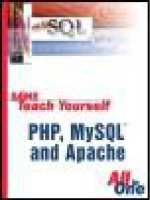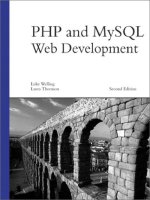mysql and msql
Bạn đang xem bản rút gọn của tài liệu. Xem và tải ngay bản đầy đủ của tài liệu tại đây (9.46 MB, 776 trang )
MySQL and mSQL
Randy Jay Yarger,
George Reese, and
Tim King
Beijing • Cambridge • Farnham • Köln • Paris • Sebastopol • Taipei • Tokyo
MySQL and mSQL
by Randy Jay Yarger, George Reese, and Tim King
Copyright © 1999 O'Reilly & Associates, Inc. All rights reserved.
Printed in the United States of America.
Published by O'Reilly & Associates, Inc., 101 Morris Street, Sebastopol, CA 95472.
Editor: Andy Oram
Production Editor: Jeffrey Liggett
Editorial and Production Services: Electro-Publishing
Printing History:
July 1999: First Edition.
Nutshell Handbook, the Nutshell Handbook logo, and the O'Reilly logo are registered
trademarks of O'Reilly & Associates, Inc. Java™ and all Java-based trademarks and
logos are trademarks or registered trademarks of Sun Microsystems, Inc., in the United
States and other countries. O'Reilly & Associates, Inc. is independent of Sun
Microsystems.
Many of the designations used by manufacturers and sellers to distinguish their
products are claimed as trademarks. Where those designations appear in this book, and
O'Reilly & Associates, Inc. was aware of a trademark claim, the designations have
been printed in caps or initial caps. The association between the image of kingfishers
and the topic of MySQL and mSQL is a trademark of O'Reilly & Associates, Inc.
While every precaution has been taken in the preparation of this book, the publisher
assumes no responsibility for errors or omissions, or for damages resulting from the use
of the information contained herein.
This book is printed on acid-free paper with 85% recycled content, 15% post-consumer
waste. O'Reilly & Associates is committed to using paper with the highest recycled
content available consistent with high quality.
ISBN: 1-56592-434-7 [9/99]
Preface
ix
I. Getting Started with MySQL and mSQL
1
1. Introduction to Relational Databases
3
What is a Database?
4
What is a Relational Database?
5
Applications and Databases
6
MySQL and mSQL
7
2. Database Design
13
Database Design
13
Normalization
16
A Logical Data Modeling Methodology
25
Physical Database Design
26
3. Installation
30
MySQL
30
mSQL
37
4. MySQL
39
Design
39
Installing MySQL
41
Running MySQL
41
Database Administration
42
MySQL Utilities
58
Performance Tuning
62
5. mSQL
68
Design
68
mSQL Versions
70
Installing mSQL
72
Running mSQL
73
Database Administration
77
mSQL Utilities
84
6. SQL According to MySQL and mSQL
90
SQL Basics
90
Creating and Dropping Tables
93
SQL Datatypes
94
Indices
100
Sequences and Auto-Incrementing
101
Managing Data
103
Queries
105
Extended Functionality
109
7. Other Mid-Range Database Engines
113
What is "Free"?
113
What MySQL and mSQL Lack
114
PostgreSQL
117
GNU SQL
118
Beagle
119
Making Comparisons
119
II. Database Programming
121
8. Database Application Architectures
123
The Client/Server Architecture
123
Data Processing
124
Data Processing
124
Object/Relational Modeling
125
The Three-tier Architecture
127
9. CGI Programming
130
What is CGI?
130
HTML Forms
131
The CGI Specification
136
Important Considerations for CGI Scripts
143
CGI and Databases
152
10. Perl
154
DBI
154
An Example DBI Application
161
Msql.pm
165
MysqlPerl
174
11. Python
181
Basic Connectivity
181
Dynamic Connectivity
184
12. PHP and Other Support for Database-driven HTML
187
Alternatives for Dynamic Content on the Web
187
W3-mSQL
189
PHP
193
Embedded Perl
195
13. C and C++
197
The Two APIs
197
Object-oriented Database Access in C++
203
14. Java and JDBC
216
What is JDBC?
216
Simple Database Access
221
Dynamic Database Access
224
A Guest Book Servlet
227
III. Reference
229
15. SQL Reference
231
MySQL SQL
231
mSQL SQL
269
16. MySQL and mSQL System Variables
275
MySQL System Variables
275
mSQL System Variables
280
17. MySQL and mSQL Programs and Utilities
MySQL Utilities
284
mSQL Utilities
299
18. PHP and Lite Reference
303
PHP
303
Lite
334
19. C Reference
345
MySQL C API
345
mSQL C API
361
20. Python Reference
368
Module: MySQL
368
Module: mSQL
372
21. Perl Reference
375
Installation
375
DBI.pm API
377
Msql.pm API
396
Mysql.pm API
412
22. JDBC Reference
416
PREFACE
In the world of computing, the 1990s may rightly be called the decade of Open Source
software. From Linux to Perl, from palmtop to mainframe, the Open Source movement
has left a mark in practically every niche of technology. This impact is especially
strong in the commercially neglected world of mid-range server applications commonly
needed by nonprofit organizations and small businesses.
The idea of mid-range servers was fairly rare in the first few decades of the computer
age. Computers were expensive items used by large institutions such as banks and
universities. Enormous time-sharing servers provided the computing power for entire
companies. Much of the software running on these systems was as monolithic as the
servers themselves. After all, because only one computer was serving several
departments—if not the whole organization—that computer had to fulfill everyone's
needs.
At the other end of the spectrum was the personal computer. With the PC revolution,
you could find one computer for every household instead of one computer for an entire
company. While these computers were easily powerful enough to satisfy the needs of a
single user, a wide gulf still existed between the capabilities—and the costs—of
personal computing and corporate computing.
The area where this gulf was most apparent was in data management. Database
applications for large mainframe servers included every feature possible. Because of
the multipurpose nature of this software, if any odd feature was needed by a single
user, it was included. Database applications that satisfied those data management needs
of the individual user emerged. However, where mainframe databases were too
massive for mid-range needs, personal databases were too narrow.
In the first half of the 1990s, the "lowly" personal computer had advanced to the point
where it was actually more powerful than the mainframe computers of yesteryear.
While hardware was no longer a barrier to mid-range computing, the lack of affordable
software was. To meet the data storage needs of a nonprofit organization or small
business, you needed an affordable server operating system and an affordable database
management system. The introduction of cheap and powerful server operating systems
like FreeBSD and Linux helped solve the operating system side of that equation.
MySQL and mSQL are two solutions that solve the database management side of the
equation. They are powerful and flexible while at the same time lightweight and
efficient. MySQL, in particular, packs a large feature set into a very small and fast
engine. While neither database engine has anywhere near the full feature set of
expensive corporate databases, they easily have enough of a feature set to meet the
needs of mid-range database management.
Audience
This book is primarily for two classes of readers. The most obvious is the reader
interested in using MySQL and mSQL from either a database administration
perspective or from a database programmer perspective. In addition, anyone who wants
to learn about relational database administration and programming without paying out
the nose for a license from one of the big guys will find MySQL or mSQL an excellent
starting point. If MySQL or mSQL is your starting point, then this book is your guide.
From a database administrator's perspective, we cover the basic methods of creating
and managing databases and tables in MySQL and mSQL. We go beyond the simple
and provide performance tuning and troubleshooting tips to help you make sure your
MySQL and mSQL applications are running their best. Finally, all of the tools that
come with MySQL and mSQL are covered in detail. We assume no prior knowledge of
SQL or relational databases.
Database programmers will find that we have covered all of the major programming
interfaces from the most popular client/server and web programming languages. When
we cover the interface for a particular language, we assume that the reader has a basic
grasp of the language in question. For example, in the Java™ chapter, we assume that
the reader knows how to write basic Java applications and now wants to learn how to
make those Java applications talk to a MySQL or mSQL database.
The immense popularity of MySQL and mSQL on the Web has made it natural to
provide a focus on CGI programming with MySQL and mSQL. Web developers should
therefore find this book useful in describing how to drive their web sites with a MySQL
or mSQL database. For these chapters, very little CGI knowledge is needed, but we still
assume that the reader is familiar with the basics of the programming language in
question.
Purpose
At first glance, the purpose of this book seems obvious: MySQL and mSQL are two of
the most popular applications offering public source code. They offer the practical
advantages of Open Source software even through their licenses are a bit too restrictive
for the Open Source mark. For anyone who has spent a significant amount of time
learning MySQL or mSQL, the answer is a little more complex.
One of the biggest complaints about Open Source projects is almost always the lack of
comprehensive and comprehensible documentation. In the case of MySQL and mSQL,
however, lack of online documentation is rarely a problem.
MySQL has a wonderfully complete and free online reference manual available from
the web site at
. This manual covers the full MySQL SQL syntax,
installation, and its C API, as well as database administration and performance tuning.
Similarly, mSQL has a good, if less comprehensive, online manual at
.
To make matters even more complex, MySQL and mSQL are both moving targets
b
ecause of rapid development. In the case of MySQL, "moving target" is a euphemism.
Thanks mainly to the efforts of Michael "Monty" Widenius, MySQL is a target moving
about as fast as a freight train. So be prepared, you may find some of the information in
this book either ahead of older versions or behind newer versions.
But wait! Don't put this book back on the shelf just yet. We knew about all of these
issues before we tackled the task of writing this book. One major reason made a book
on this topic not only justified, but essential. The worlds of MySQL and mSQL are not
limited to a couple of database engines. Because of the degree to which they have been
embraced by the Open Source community, MySQL and mSQL also encompass a host
of tools for managing and programming applications for these databases. The purpose
of this book
is therefore to provide a single, definitive guide to these database engines and the world
of APIs and tools used to build end-to-end database solutions. Anyways, a book is
much easier to read in the bathroom or on a plane than online documentation.
Using This Book
We have divided this book into three sections. The first section covers getting started
and managing a MySQL or mSQL database. The second section builds upon that
foundation by demonstrating how you build applications that use your MySQL or
mSQL database. Finally, we provide a full reference section to provide a resource for
quickly looking up any of the APIs or tools we cover in the first two sections.
If you are a member of the audience we described earlier, you fall into one of three
categories:
• MySQL users and administrators
• mSQL users and administrators
• Undecided, but definitely will be using either MySQL or mSQL
We have directed the first section of the book at database administrators. We start at a
high level by addressing the question of what exactly is a database. Perhaps you have
experience with databases; if so, such a discussion is certainly way too basic for you.
You will still want to catch the end of Chapter 1, Introduction to Relational Databases,
for a short introduction to MySQL and mSQL. This discussion is of particular interest
to anyone who has not yet made a decision on which database to use and who wants a
short overview of the two.
Chapter 2, Database Design, may appear at first unimportant. It is, on the contrary, one
of the most important chapters of the book. Proper database design is essential for both
database administrators and programmers if the goal is to build database applications
that will be flexible enough to scale as application needs change. You also need a
proper database design if you want your database to actually perform well.
Chapter 3, Installation, covers installation of both engines.
If you have chosen a particular database engine, you can skip either Chapter 4, MySQL,
or Chapter 5, mSQL. Each chapter is specific to one of the two database engines and is
completely irrelevant to users of the other engine. If, however, you have not yet made a
decision, then these two chapters will be key to your selection process.
We close out the administrative section with a discussion of the variants of SQL
presented by MySQL and mSQL. While programmers may be largely uninterested in
the first section, they will find the need to occasionally refer to this section even if they
are experienced SQL programmers. Anyone who has never before used SQL definitely
needs to read this chapter.
The second section begins with an overview of the client/server programming model.
This discussion is very high level, but it is key to understanding how the database and
the application programming work together to build a solid database application. Of
course, if you are experienced with client/server programming in other environments,
this sort of architectural discussion may be old hat to you. The rest of the section
contains chapters devoted to programming in specific languages or using specific tools.
Of particular interest to web programmers will be the chapters on Perl, Java, Python,
and PHP.
The book closes with a reference section that covers all of the tools and APIs we address
in the book.*
On MySQL and mSQL
We have attempted to provide balanced and full coverage of both MySQL and mSQL
in this book. A single book on both engines makes sense since they are so similar.
While they do not have common code, the similarities are quite intentional. In order to
be consistent, we have chosen always to use the expression ''MySQL and mSQL" or
"MySQL or mSQL" wherever something is true of both database engines. MySQL
comes first only because we arbitrarily decided to make the most popular of the two
appear first. Where MySQL or mSQL appear alone in a sentence without the other, the
sentence is specifically addressing an issue associated with that database engine.
Except for chapters dedicated solely to one engine or the other, you can assume that
MySQL or mSQL appearing alone in a sentence means that the sentence is true only of
the database being mentioned.
Conventions Used in this Book
The following conventions are used in this book:
Constant width
Used for anything that might appear in a program, including keywords, function
names, SQL commands, and variable names. This font is also used for code
examples, output displayed by commands, and system configuration files.
Constant width bold
Used for user input.
Constant width italic
Indicates an element (e.g., a filename or variable) that you supply.
Italic
Used for directory names, filenames, program names, Unix commands, and URLs.
This font is also used to introduce new terms and for emphasis.
* Chapter 22, JDBC Reference, is a revised version of an appendix from O'Reilly's Database
Programming with JDBC and Java by George Reese.
The owl symbol is used to indicate a tip, suggestion, or general
note.
The turkey symbol is used to indicate a warning.
Comments and Questions
Please address comments and questions concerning this book to the publisher:
O'Reilly & Associates
101 Morris Street
Sebastopol, CA 95472
800-998-9938 (in the U.S. or Canada)
707-829-0515 (international or local)
707-829-0104 (FAX)
You can also send us messages electronically. To be put on our mailing list or to
request a catalog, send email to:
To ask technical questions or comment on the book, send email to:
Before submitting a bug report concerning MySQL, please check the online manual
(and particularly the list of problems and common errors) at:
/>
You can search the MySQL mailing list at:
and the MySQL web site at:
Acknowledgments
The authors would first like to thank their editor Andy Oram for both his skill at
making our work look more professional and for the less obvious and likely less
enjoyable task of putting us back on focus when our minds would wander.
We also owe a huge debt of gratitude to those who provided us with a critical look at
the book. Anyone familiar with MySQL knows the name Michael Widenius, the head
of the MySQL project. He and another member of the MySQL team, Paul DuBois, sent
in many valuable comments. Brian Jepson, one of the authors of the Official Guide to
Mini SQL (John Wiley & Sons, Inc.), kindly offered us valuable input on our mSQL
coverage. Finally, Glenn MacGregor and Michael Schecter provided useful comments
on the book overall.
From Randy Yarger
I would like to thank my fiancée, Stacie Sheldon, for the support and love that has kept
me sane. I would also like to thank Andy Oram for encouraging a relatively unknown
author. Finally, but definitely not lastly, I would like to thank the ones that made it
possible for me to be here, my mother, my father, and my creator.






![effortless e-commerce with php and mysql [electronic resource]](https://media.store123doc.com/images/document/14/y/sy/medium_syr1401465529.jpg)


